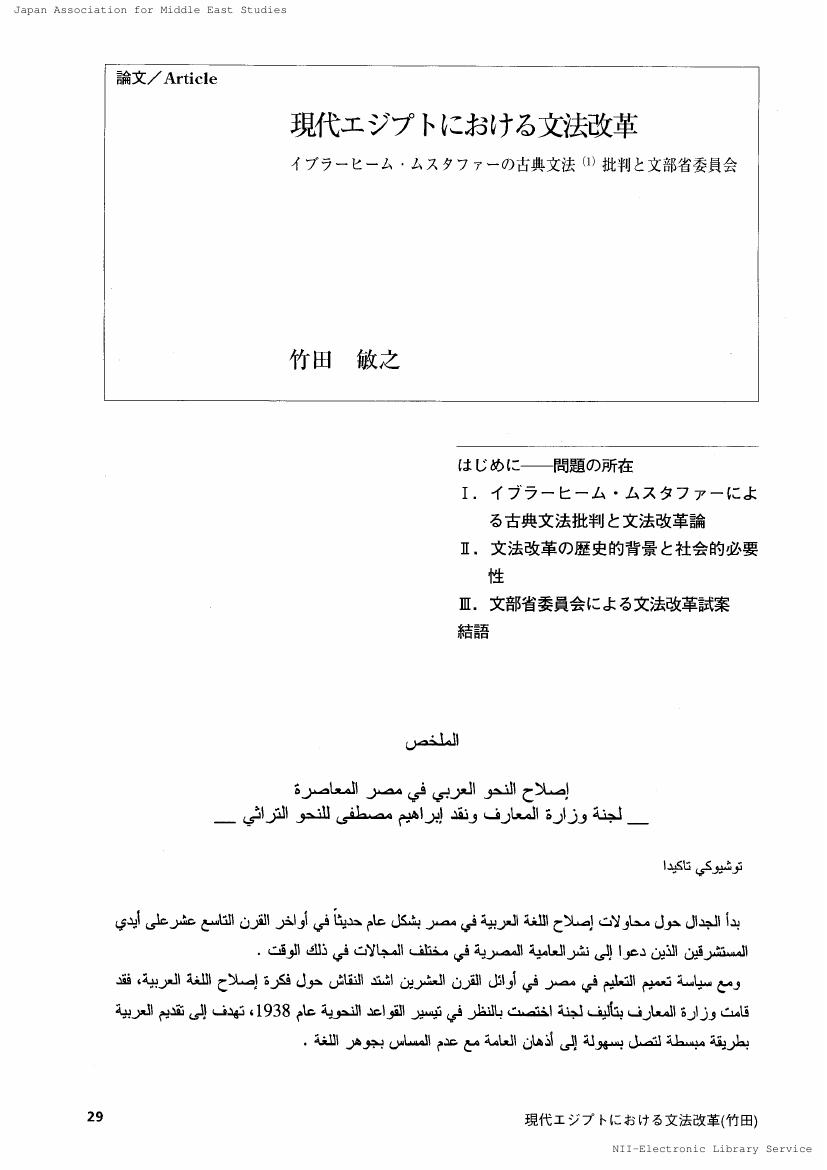- 著者
- 竹田 敏之
- 出版者
- 日本中東学会
- 雑誌
- 日本中東学会年報 (ISSN:09137858)
- 巻号頁・発行日
- vol.22, no.2, pp.29-52, 2007-03-20 (Released:2018-03-30)
- 著者
- 竹田 敏之
- 出版者
- 京都大学東南アジア研究所
- 雑誌
- Kyoto Working Papers on Area Studies: G-COE Series
- 巻号頁・発行日
- vol.23, pp.1-29, 2009-02
The modern Arab world was born from the common bonds of the Arabic language and Arabic culture out of the process of the dismantlement of the traditional Islamic world represented by the Ottoman Empire in the nineteenth and early twentieth centuries. The present author has been examining the formation of the modern Arab world and the establishment of Arabic as a modern national language. For Arabic to become a modern language, it was crucial to structure the grammar in a way that was clear and easy for pupils in elementary and secondary schools to understand. Adapting traditional Arabic vocabulary to a modern context was another crucial task. In this paper, we discuss how the men of letters and linguistic specialists in the Arab world tackled this essential task of adopting a modern vocabulary in the 19th and 20th Centuries. Traditionally, the adaptation of foreign concepts and vocabulary was called "ta'rīb", or "Arabization". In the classical periods, there were numerous discussions on this subject, as the Abbasid era witnessed a great period when a large number of mainly Greek scientific works were translated into Arabic. The Nahda (renewal) period in the 19th century, second only to the Abbasid precedent in its massive size, marked another great period when modern Western texts were translated into Arabic. Of the intellectuals of the Nahda period, al-Tahtawi, al-Shidyaq, and al-Yaziji were the most notable for their contribution to the "Arabization" of modern concepts and vocabularies. In this paper, their contributions are carefully cited and examined. They also called for the formation of language academies where urgent issues for the Arabic language could be addressed and discussed. In the 20th century, such academies were established in Syria, Egypt, Iraq and other Arabic-speaking countries. These academies have served as a common public forum for debates on linguistic and cultural issues that concern all Arabic speaking peoples. Ta'rīb, or the adoption of modern terms in scientific and cultural fields as well as terms used in modern daily life was, in addition to simply importing foreign words in transliterated forms, basically done by one of the following two methods. The first, ishtiqāq (derivation), which created derived words from word-roots, was proposed and used widely to produce many new words. Since this method represents one 2 of the most important characteristics of Arabic, that is, producing new words by derivation, it has been favored in the process of importing Western concepts. The second, naḥt, that is, minting a new word by putting two or three words together, was also proposed. Some scholars preferred this method and tried hard to promote it. Arabic academies spent a long time discussing the naht method of creating new words, and came to the conclusion that, while it is very useful, its function should be restricted to scientific fields. Apparently, the need to foster Arabic as the "common and authentic" language of the Arabs influenced this outcome, while the need to develop a "modern" vocabulary could be served by either of the two methods.
1 0 0 0 OA 現代中東の「ワタン(祖国)」的心性をめぐる表象文化の発展的研究
- 著者
- 岡 真理 宮下 遼 山本 薫 石川 清子 藤元 優子 福田 義昭 鵜戸 聡 田浪 亜央江 中村 菜穂 前田 君江 鈴木 珠里 石井 啓一郎 徳原 靖浩 細田 和江 磯部 加代子 岡崎 弘樹 鈴木 克己 栗原 俊秀 竹田 敏之
- 出版者
- 京都大学
- 雑誌
- 基盤研究(B)
- 巻号頁・発行日
- 2015-04-01
アラビア語、ペルシア語、トルコ語、ヘブライ語など中東の諸言語で、中東地域で生産される作品のみならず、中東に歴史的出自を持つ者によって、欧米など地理的中東世界を超えた地域で、英語、仏語、独語、伊語などの西洋の諸言語で生み出される作品をも対象に、文学や映画などさまざまなテクストに現れた「ワタン(祖国)」表象の超域的な分析を通して、「ワタン」を軸に、近現代中東世界の社会的・歴史的ありようとそのダイナミズムの一端と、国民国家や言語文化の境界を越えた共通性および各国・各地域の固有性を明らかにすると同時に、近現代中東の人々の経験を、人間にとって祖国とは何かという普遍的問いに対する一つの応答として提示した。

